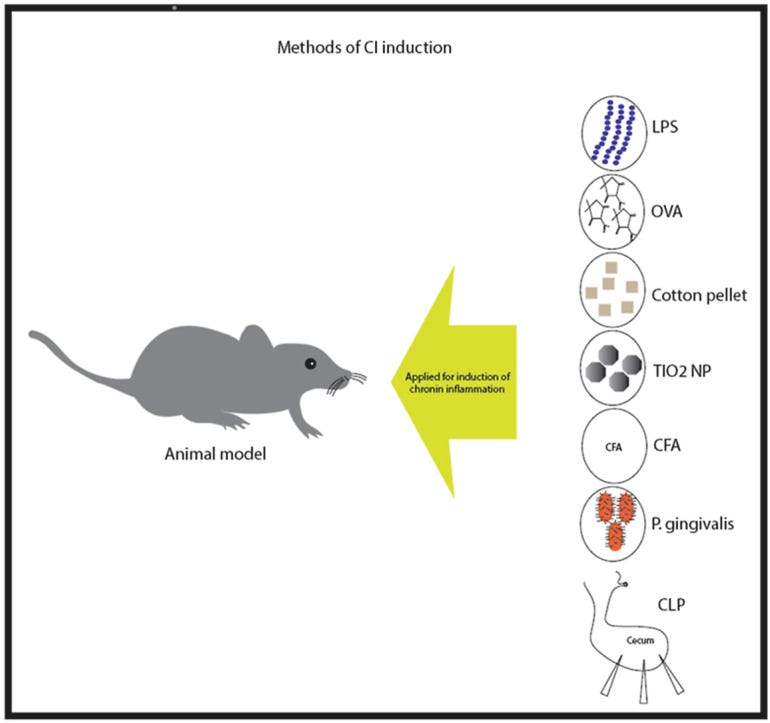Repeated Exposure to the Spike Protein and the Induction of Chronic Inflammation: Using Humans as an Experimental Animal Model
The Spike Protein as a lipopolysaccharide delivery system induces a state of chronic inflammation – why some may be more affected than others.
Different species of endotoxin arise from different sources, ending up in the blood or brain. Blood endotoxin increase pro-inflammatory cytokines in blood, and inflammatory activates the blood-brain barrier (BBB) and circumventricular organs (CVO), recruiting leucocytes into the brain and increasing brain cytokines that activate microglia, resulting in synaptic and neuronal loss.
As readers of this Substack are aware, I have been constantly searching for reasons why some are more immediately affected by Spike Protein pathologies and others seem to have no apparent affects at all. I have discovered a mechanism that can clearly explain this. Also, it can explain why repeated exposures to the Spike Protein are potentially very dangerous.
One of the overarching causes of chronic disease is chronic inflammation. In fact, there are animal models of this. Though obviously cruel to the animals, the research has allowed for the discovery of how chronic inflammation induces chronic disease and how these conditions may be treated.
The Spike Protein acts as an inducer of chronic inflammation (CI).
Of all the methods of inducing chronic inflammation, using lipopolysaccharides (LPS) is by far one of the most effective.
LPS is one of the known agents for the induction of CI. It is used in a variety of studies that have investigated physiology, immunology, and metabolism (Rathinam et al., 2019; Yirmiya et al., 2001). As this agent is related to septicemia, it can also be used in the studies that assess the role of antibodies and inhibitors in targeting LPS (Baumgartner et al., 1990; Jang et al., 2017).
Interestingly, This activation of CI causes virtually all of the pathologies we have observed in association with the Spike Protein.
CI causes several diseases due to its related damages. Parts of the figure were drawn by using pictures from Servier Medical Art. Servier Medical Art by Servier is licensed under a Creative Commons Attribution 3.0 Unported License (https://creativecommons.org/licenses/by/3.0/).
Experimental animal models of chronic inflammation
https://www.ncbi.nlm.nih.gov/pmc/articles/PMC10276141/
So, why is this important in relation to the presence of the Spike Protein?
In this study, we established LPS interactions with both S1 and S2 subunits by blue native polyacrylamide gel electrophoresis (BN-PAGE) and mapped LPS binding to the S2 pocket as well as the NTD and RBD pockets by amide hydrogen–deuterium exchange mass spectrometry (HDXMS). Calculation of potentials of mean force (PMFs) within a MD simulation framework, supported by microscale thermophoresis (MST) binding experiments, indicates that LPS binds with strong affinities to the RBD and NTD pockets on the S1 subunit, while the S2 pocket represents a weaker binding site compared to CD14, suggesting its potential role as an intermediate in the LPS receptor transfer cascade (Huber et al., 2018). Furthermore, monocytic THP-1 cell assays show boosting of nuclear factor-kappa B (NF-κB) activation by LPS in the presence of the S2 subunit, but not with the S1 subunit. NF-κB reporter mice show enhanced inflammatory response with both S1 and S2 subunits of the S protein. Finally, the boosting effect on LPS is conserved in Omicron S protein in vitro and in vivo, albeit at a moderately reduced level. Moreover, the Omicron variant shows a reduced affinity to the LPS-binding site on the RBD, as shown by MST, tryptophan fluorescence quenching assays, and MD simulations. Collectively, a molecular mechanism of how the SARS-CoV-2 S protein augments LPS-mediated hyperinflammation emerges, whereby the S protein acts as an additional LPS delivery system to its receptors.
SARS-CoV-2 spike protein as a bacterial lipopolysaccharide delivery system in an overzealous inflammatory cascade
https://academic.oup.com/jmcb/article/14/9/mjac058/6761401
This means that the Spike attaches to and delivers LPS systemically. One can certainly understand how acquiring the virus through the respiratory or digestive systems would result in a plethora of LPS being “mined” by the Spike Protein. Yet, what we must bear in mind is that we ALWAYS have LPS circulating in our bodies.
Endotoxin is a lipopolysaccharide (LPS), constituting much of the outer membrane of gram-negative bacteria, present at high concentrations in gut, gums and skin and in other tissue during bacterial infection. Blood plasma levels of endotoxin are normally low, but are elevated during infections, gut inflammation, gum disease and neurodegenerative disease.
The endotoxin hypothesis of neurodegeneration
https://jneuroinflammation.biomedcentral.com/articles/10.1186/s12974-019-1564-7
And there it is. The inflammatory effects of LPS you have systemically present is amplified in the presence of the Spike Protein. If you happen to have, or develop, any of the conditions which increase the systemic level of LPS, the effects are greatly enhanced.
One could argue that we have been used as an Experimental Animal Model of Chronic Inflammation.
I will continue to work on adding to the therapeutics we have discovered and discussed to ameliorate this, and to, hopefully, rid the body of the presence of the Spike Protein.






All Adverse Events listed in the 393 page Pfizer PSUR from June 2022 can be explained by known mechanisms of Endotoxin harms.
https://geoffpain.substack.com/p/endotoxin-harms-list-a-k
The ones that took the vaccine were the experiment. Now we see the results. And they are deadly. Someone needs to be held accountable.